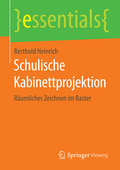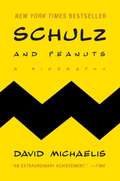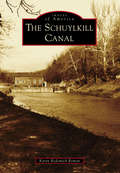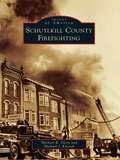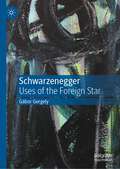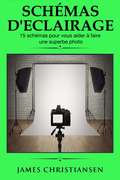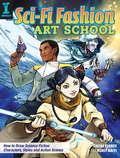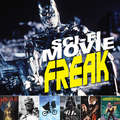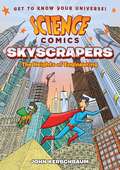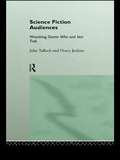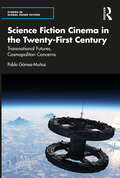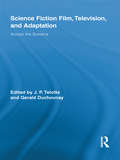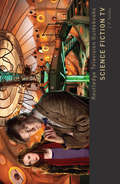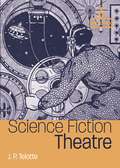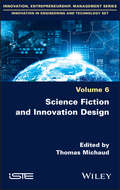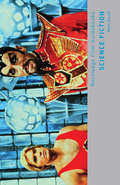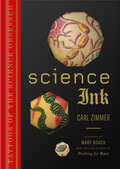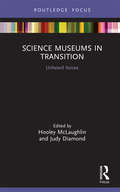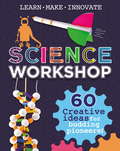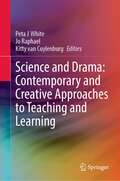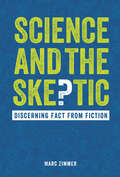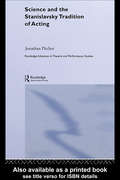- Table View
- List View
Schulische Kabinettprojektion: Räumliches Zeichnen im Raster (essentials)
by Berthold HeinrichBerthold Heinrich stellt die mathematischen und zeichnerischen Grundlagen für die Darstellung von Objekten im Raum auf kariertem Papier vor. Dabei präsentiert er auch die Nutzung von Software. In der Schule wird oft kariertes Papier als Raster zur Darstellung von Flächen und Körpern genutzt. Allerdings werden, selbst in einigen Druckwerken, z. B. die entstehenden Ellipsen und Winkelbögen ungenau gezeichnet oder eine Kugelkontur falsch als Kreis dargestellt. Im vorliegenden Essential werden die korrekten Verfahren sowohl theoretisch als auch an konkreten Beispielen vorgestellt und können meist direkt umgesetzt werden. Einige aufwändigere Abläufe stellt der Autor anschaulich an Beispielen dar.
Schuylkill Canal, The
by Karen Rodemich RomanIn 1825, the Schuylkill Navigation Company completed a waterway of 108 miles, linking Port Carbon to Philadelphia. The waterway, known as the Schuylkill Navigation but commonly referred to today as the Schuylkill Canal, consisted of a system of interconnected canals (often called reaches), locks, and slack-water pools to transport anthracite coal. Before that time, Philadelphia depended on the import of coal from Europe. The Schuylkill Canal was operational until 1931, around the time of the collapse of commercial traffic in the navigation. Only two watered stretches of the canal remain today: the approximately 2.5 miles of the original 3.5 miles of Oakes Reach between Oaks and Mont Clare and the one-mile reach in Manayunk. While these areas are no longer used for navigation, they are enjoyed recreationally by many in the surrounding communities.
Schuylkill County Firefighting (Images of America)
by Michael R. Glore Michael J. KitsockFrom the inception of the Friendship Hose Company No. 1 of Orwigsburg in 1820 to the organization of the West Penn Fire Company No. 1 in 1999, more than 130 volunteer fire companies have served Schuylkill County. This proud tradition of volunteer service for the protection of fellow man continues strong to this day as scores of volunteer firefighters continue to serve their communities. Using the archives of the Schuylkill County Historical Society, Schuylkill Historical Fire Society, and many fire companies and individuals, Schuylkill County Firefighting captures in its images the daunting challenges faced by generations of Schuylkill firefighters. Block-burning conflagrations, deadly explosions, and traumatic rescues reveal the heroic battles faced over the years by these dedicated public servants.
Schwarzenegger: Uses of the Foreign Star
by Gábor GergelyThis book analyses the uses of Arnold Schwarzenegger as a foreign star in Hollywood through a film philosophical, de-westernizing and sonic critical framework. It offers very close readings of the film texts, of the roles Schwarzenegger performs, and the rhetorical strategies he adopts outside his film performances to show that in spite of attempts to occupy the position of an emblematic member of the U.S. national body Schwarzenegger remains irrevocably outside as an accented migrant body continuously accumulating markers of belonging that by their very necessity attest to their insufficiency. The book’s central project is to trace back, from the uses to which a migrant star such as Schwarzenegger is put on the screen, the construction of a sense or idea of a U.S. national community through the cinema. Given that the appeal to the American myth of an immigrant nation that promises to erase difference is fundamental to the Schwarzenegger star persona, the central aim of this book is to explore the uses of his stardom as an embodiment of the promise of America and its contradictions and exclusions.
Schémas d'éclairage 15 schémas pour vous aider à faire une superbe photo
by James ChristiansenVous en avez des photographies trop sombres, trop claires ou tout simplement pas « comme il faut » ? Mes schémas d'éclairage vous aideront dès aujourd'hui à prendre de meilleures photos avec un éclairage optimal ! Prendre de superbes photos n'est pas si difficile, en particulier avec les incroyables avancées technologiques actuelles en matière d'appareil photo. L'un des concepts fondamentaux que vous devez comprendre est la manière de configurer correctement l'éclairage d'une photographie. Ce livre vous montrera exactement comment faire à l'aide de schémas d'éclairage faciles à suivre. Ce livre présente des schémas d'éclairage pour : 1. Portraits de bébé 2. Photos d'un seul sujet 3. Portraits de famille 4. Portraits en gros plan 5. Portraits d'animaux domestiques 6. Photos de produits (idéal pour eBay ou Craiglist !) 7. Portraits de silhouette Et bien plus encore, y compris encore plus de schémas et de conseils en matière équipement ! Arrêtez de prendre de mauvaises photos et commencez à prendre de superbes photos avec ces schémas d'éclairage simples !
Sci-Fi Fashion Art School: How to Draw Science Fiction Characters, Styles and Action Scenes
by Irene Flores Ashly RaitiYour guide to drawing sci-fi characters! From post-apocalyptic Earth to extraterrestrial civilizations, get ready to explore the farthest reaches of your imagination and evoke your own original sci-fi worlds. With Sci-Fi Fashion Art School you will learn to draw everything from scavenger-wear and exosuits to alien garb and space explorer uniforms. Starting with simple guidelines, you'll discover how to create distinct characters just by varying facial features, body mass and hair. Beyond the mechanics of drawing, you'll learn to make strategic creative choices by asking questions like: What drives your characters? Do they dress for survival or social status? What materials are at their disposal? The answers help you develop fashions, weapons and accessories uniquely suited to the environmental and cultural conditions of your particular world. The Sci-Fi genre has no limits. With the instruction and inspiration inside, neither will you. Launch Yourself Into New Worlds!Learn how to draw clothing, hairstyles, tools, weapons, jewelry, prosthetic parts, and more.Create characters, settings and scenes with 21 step-by-step demonstrationsExplore several different sci-fi world scenarios: The Wasteland, Urban Dystopia, iRobots and The Final Frontier.Develop a diverse cast of characters, including enforcers, scientists, survivors, rulers, rebels, servants, bad guys and others.
Sci-Fi Movie Freak
by Robert C. Ring"I'll be back." -- The Terminator, The Terminator (1984) To the movies, that is. And so will you with the help of Sci-Fi Movie Freak, a celebration of some of the greatest science-fiction movies of all time. Your inner geek will freak finding everything from classics like Metropolis, Forbidden Planet, and 2001: A Space Odyssey to modern movies including Avatar, Moon, and Inception, and even the entertaining "failures" like Robot Monster, Gammera the Invincible, and Battlefield Earth. Movies are divided into various chapters including Best of the Best, Further Essentials, and Lesser-Known Gems. Features more than 100 movies 250+ photos of movie stills and posters Top 10 lists of the best directors, female characters, villains and moreFree DVD included of the magnificently bad cult classic Plan 9 From Outer Space.
Science Arts: Exploring Science Through Hands-On Art Projects (Bright Ideas for Learning #4)
by Jean Potter MaryAnn F Kohl K. Whelan DeryGet ready to explore the world of science through art with these open-ended experiments! Science Arts introduces the scientific magic of crystals, light, constellations, plants, and more through creative art projects. Each of the more than 100 hands-on projects is designed to help children discover essential science topics through a creative process unique to each individual. Concepts include light and sight, motion and energy, and nature and ecology. Science Arts provides both teachers and parents with a diverse range of activities for making science creative, fun and fascinating. The possibilities are wide open and endless!
Science Comics: The Heights of Engineering (Science Comics)
by John KerschbaumLeave no brick unturned in John Kerschbaum's Science Comics: Skyscrapers, the latest volume in First Second’s action-packed nonfiction graphic novel series for middle-grade readers!Every volume of Science Comics offers a complete introduction to a particular topic—dinosaurs, the solar system, volcanoes, bats, robots, and more. These gorgeously illustrated graphic novels offer wildly entertaining views of their subjects. Whether you're a fourth grader doing a natural science unit at school or a thirty-year-old with a secret passion for airplanes, these books are for you!In this volume, join a pair of superheroes as they uncover the secrets of skyscrapers, from the great Egyptians pyramids to the world’s tallest building. Read along and learn how skyscrapers are a bold combination of applied physics, ingenuity, and a lot of hard work!
Science Fiction Audiences: Watching Star Trek and Doctor Who (Popular Fictions Series)
by Henry Jenkins John TullochScience Fiction Audiences examines the astounding popularity of two television "institutions" - the series Doctor Who and ^Star Trek. Both of these programmes have survived cancellation and acquired an following that continues to grow. The book is based on over ten years of research including interviews with fans and followers of the series. In that period, though the fans may have changed, and ways of studying them as "audiences" may have also changed, the programmes have endured intact, with Star Trek for example now in its fourth television incarnation. John Tulloch and Henry Jenkins dive into the rich fan culture surrounding the two series, exploring issues such as queer identity, fan meanings, teenage love of science fiction, and genre expectations. They encompass the perspectives of a vast population of fans and followers throughout Britain, Australia and the US, who will continue the debates contained in the book, along with those who will examine the historically changing range of audience theory it presents. and continue to attract a huge community of fans and followers. Doctor Who has appeared in nine different guises and Star Trek is now approaching its fourth television incarnation.Science Fiction Audiences examines the continuing popularity of two television 'institutions' of our time through their fans and followers. Through dialogue with fans and followers of Star Trek and Dr Who in the US, Britain and Australia, John Tulloch and Henry Jenkins ask what it is about the two series that elicits such strong and active responses from their audiences. Is it their particular intervention into the SF genre? Their expression of peculiarly 'American' and 'British' national cultures. Their ideologies and visions of the future, or their conceptions of science and technology? Science Fiction Audiences responds to a rich fan culture which encompasses debates about fan aesthetics, teenage attitudes to science fiction, queers and Star Trek, and ideology and pleasure in Doctor Who. It is a book written both for fans of the two series, who will be able to continue their debates in its pages, and for students of media and cultural studies, offering a historical overview of audience theory in a fascinating synthesis of text, context and audience study.
Science Fiction Cinema in the Twenty-First Century: Transnational Futures, Cosmopolitan Concerns (Studies in Global Genre Fiction)
by Pablo Gómez-MuñozRecent films are increasingly using themes and conventions of science fiction such as dystopian societies, catastrophic environmental disasters, apocalyptic scenarios, aliens, monsters, time travel, teleportation, and supernatural abilities to address cosmopolitan concerns such as human rights, climate change, economic precarity, and mobility. This book identifies and analyses the new transnational turn towards cosmopolitanism in science fiction cinema since the beginning of the twenty-first century. The book considers a wide selection of examples, including case studies of films such as Elysium, In Time, 2012, Andrew Niccol’s The Host, Codependent Lesbian Space Alien Seeks Same, and Cloud Atlas. It also questions the seeming cosmopolitanism of these narratives and exposes how they sometimes reproduce social hierarchies and exploitative practices. Dealing with diverse, interdisciplinary concerns represented in cinema, this book in the Studies in Global Genre Fiction series will be of interest to readers and scholars working in the fields of science fiction, film and media studies, cosmopolitanism, border theory, popular culture, and cultural studies. It will also appeal to fans of science fiction cinema and literature.
Science Fiction Cinema in the Twenty-First Century: Transnational Futures, Cosmopolitan Concerns (Studies in Global Genre Fiction)
by Pablo Gómez-MuñozRecent films are increasingly using themes and conventions of science fiction such as dystopian societies, catastrophic environmental disasters, apocalyptic scenarios, aliens, monsters, time travel, teleportation, and supernatural abilities to address cosmopolitan concerns such as human rights, climate change, economic precarity, and mobility. This book identifies and analyses the new transnational turn towards cosmopolitanism in science fiction cinema since the beginning of the twenty-first century.The book considers a wide selection of examples, including case studies of films such as Elysium, In Time, 2012, Andrew Niccol’s The Host, Codependent Lesbian Space Alien Seeks Same, and Cloud Atlas. It also questions the seeming cosmopolitanism of these narratives and exposes how they sometimes reproduce social hierarchies and exploitative practices.Dealing with diverse, interdisciplinary concerns represented in cinema, this book in the Studies in Global Genre Fiction series will be of interest to readers and scholars working in the fields of science fiction, film and media studies, cosmopolitanism, border theory, popular culture, and cultural studies. It will also appeal to fans of science fiction cinema and literature.
Science Fiction Film, Television, and Adaptation: Across the Screens (Routledge Research in Cultural and Media Studies)
by J. P. Telotte and Gerald DuchovnayWhile film and television seem to be closely allied screen media, our feature films and television series have seldom been successfully adapted across those screens. In fact, rather than functioning as portals, those allied media often seem, quite literally, screens that filter out something that made the source work so popular in its original form. Differences in budget, running times, cast, viewing habits, screen size and shape all come into play, and this volume’s aim is to track a number of popular texts in the course of their adaptive journeys across the screens in order to sketch the workings of that cross-media adaptation. For its specific examples, the volume draws on a single genre—science fiction—not only because it is one of the most popular today in either film or television, but also because it is arguably the most self-conscious of contemporary genres, and thus one that most obviously frames the terms of these technological adaptations. The essays included here mine that reflexive character, in both highly successful and in failed efforts at cross-media adaption, to help us understand what film and television achieve in screening science fiction, and to reveal some of the key issues involved in all of our efforts to navigate the various screens that have become part of contemporary culture.
Science Fiction TV (Routledge Television Guidebooks)
by J. P. TelotteThe first in the Routledge Television Guidebooks series, Science Fiction TV offers an introduction to the versatile and evolving genre of science fiction television, combining historical overview with textual readings to analyze its development and ever-increasing popularity. J. P. Telotte discusses science fiction’s cultural progressiveness and the breadth of its technological and narrative possibilities, exploring SFTV from its roots in the pulp magazines and radio serials of the 1930s all the way up to the present. From formative series like Captain Video to contemporary, cutting-edge shows like Firefly and long-lived popular revivals such as Doctor Who and Star Trek, Telotte insightfully tracks the history and growth of this crucial genre, along with its dedicated fandom and special venues, such as the Syfy Channel. In addition, each chapter features an in-depth exploration of a range of key historical and contemporary series, including: -Captain Video and His Video Rangers -The Twilight Zone -Battlestar Galactica -Farscape -Fringe Incorporating a comprehensive videography, discussion questions, and a detailed bibliography for additional reading, J. P. Telotte has created a concise yet thought-provoking guide to SFTV, a book that will appeal not only to dedicated science fiction fans but to students of popular culture and media as well.
Science Fiction Theatre (TV Milestones Series)
by J. P. TelotteIn the wake of the juvenile space operas of the early 1950s, a groundbreaking series debuted and paved the way for one of viewers’ favorite genres today: adult-oriented science fiction. Science Fiction Theatre aired with a fresh anthology-style narrative from the vision of veteran producer Ivan Tors and with compelling narration by Truman Bradley. Created by industry-leading syndicator Ziv Television Programs, the show pioneered a scientifically based approach to aliens, telepathy, and the mysteries of the universe that provided a model for Rod Serling’s The Twilight Zone (1959–64) and a myriad of acclaimed programs that followed, including The Outer Limits (1963–65), The Ray Bradbury Theater (1985–92),and Black Mirror (2011–present). This book contextualizes Science Fiction Theatre within the budding American television industry of the 1950s, as powerful networks and independent producers and syndicators vied to create and distribute programming to an audience eager to embrace this new, free medium. Including a complete videography of this historically neglected series, author J. P. Telotte illuminates Science Fiction Theatre as a touchstone for understanding the development of science fiction media and the dynamic nature of early television broadcasting.
Science Fiction and Innovation Design
by Thomas MichaudScience fiction is often presented as a source of utopia, or even of prophecies, used in capitalism to promote social, political and technoscientific innovations. Science Fiction and Innovation Design assesses the validity of this approach by exploring the impact this imaginary world has on the creativity of engineers and researchers. Companies seek to anticipate and predict the future through approaches such as design fiction: mobilizing representations of science fiction to create prototypes and develop scenarios relevant to organizational strategy. The conquest of Mars or the weapons of the future are examples developed by authors to demonstrate how design innovation involves continuous dialogue between multiple players, from the scientist to the manager, through to the designers and the science fiction writers.
Science Fiction: Marxism And Science Fiction (Routledge Film Guidebooks)
by Dr Mark BouldScience Fiction explores the genre from 1895 to the present day, drawing on examples from over forty countries. It raises questions about the relationship between science fiction, science and technology, and examines the interrelationships between spectacle, narrative and self-reflexivity, paying particular attention to the role of special effects in creating meaning and affect. It explores science fiction’s evocations of the sublime, the grotesque, and the camp, and charts the ways in which the genre reproduces and articulates discourses of colonialism, imperialism and neo-liberal globalization. At the same time, Science Fiction provides a thorough analysis of the genre’s representation of race, class, gender and sexuality, making this text an essential guide for students, academics and film fans alike. Key films discussed include: Le voyage dans la lune (1902) 20,000 Leagues under the Sea (1916) L’Atlantide (1921) King Kong (1933, 2005) Gojira (1954) La Jetée (1962) The Abominable Dr Phibes (1971) Tetsuo (1989) Sleep Dealer (2008) Avatar (2009)
Science Ink: Tattoos of the Science Obsessed
by Carl ZimmerBody art meets popular science in this elegant, mind-blowing collection, written by renowned science writer Carl Zimmer. This fascinating book showcases hundreds of eye-catching tattoos that pay tribute to various scientific disciplines, from evolutionary biology and neuroscience to mathematics and astrophysics, and reveals the stories of the individuals who chose to inscribe their obsessions in their skin. Best of all, each tattoo provides a leaping-off point for bestselling essayist and lecturer Zimmer to reflect on the science in question, whether its the importance of an image of Darwins finches or the significance of the uranium atom inked into the chest of a young radiologist.
Science Museums in Transition: Unheard Voices (Museums in Focus)
by Judy Diamond Hooley McLaughlinScience Museums in Transition: Unheard Voices considers how museums can adapt their exhibits, programs, and organizational structures to the diversity of ideas, people, and cultures that speak to modern science. This collection contains individual expressions by museum insiders addressing a range of particular perspectives – Native American, African American, Latinx, Islamic, Israeli, Danish, white North American. These reflections provide guidance to the museum community as to how their institutions can become more thoughtful, more welcoming to diverse audiences, and more cognizant of the ways that different people incorporate science into their daily lives. As a whole, the book emphasizes the need for museums to engage in dialogue with their visitors – not merely to present them with information – and to offer the opportunities to share experiences, exchange perspectives, and thereby advance science learning through a dynamic and collective process. Science Museums in Transition is intended to further discussion on how museums address the political and social ramifications of science and, as such, should be of great interest to academics, researchers and postgraduate students working in the fields of museum studies, science, anthropology, education and history. It should also be essential reading for museum professionals around the globe.
Science Workshop: 60 Creative Ideas for Budding Pioneers
by Anna ClaybourneLearn, make and innovate with this bumper book packed with sixty projects. Science Workshop is the go-to guide for creative and unique experiments. With chapters on art, food, nature, pure science and technology, this book will have a great 'make' for you. Step-by-step instructions can help you:-Take to the skies with a plane inspired by the Wright brothers-Light up the world with a neon sign influenced by artist Tracy Emin-Construct a stunt ramp to get to grips with forces like Galileo Galilei-And much, much more! All the projects in Science Workshop are prompted by featured profiles of great scientists, artists and engineers. Learn about and create the experiments and builds that have led to world-changing discoveries, amazing machines and inspiring artworks. Perfect for KS2 science and technology classes aged 9 and up.
Science and Drama: Contemporary and Creative Approaches to Teaching and Learning
by Peta J White Jo Raphael Kitty Van CuylenburgThis edited volume presents interdisciplinary and transdisciplinary approaches to drama and science in education. Drawing on a solid basis of research, it offers theoretical backgrounds, showcases rich examples, and provides evidence of improved student learning and engagement. The chapters explore various connections between drama and science, including: students’ ability to engage with science through drama; dramatising STEM; mutuality and inter-relativity in drama and science; dramatic play-based outdoor activities; and creating embodied, aesthetic and affective learning experiences. The book illustrates how drama education draws upon contemporary issues and their complexity, intertwining with science education in promoting scientific literacy, creativity, and empathetic understandings needed to interpret and respond to the many challenges of our times. Findings throughout the book demonstrate how lessons learned from drama and science education can remain discrete yet when brought together, contribute to deeper, more engaged and transformative student learning.
Science and the Skeptic: Discerning Fact from Fiction
by Marc ZimmerFake news, pseudoscience, and quackery have become scourges, spreading through society from social media all the way to Congress. The line between entertainment and reality, between fact and fiction, has become blurred. Some of the most crucial issues of our time—climate change, vaccines, and genetically modified organisms—have become prime targets for nefarious disinformation campaigns. Far too many people have become distrustful of real science. Even those who still trust science no longer know what to believe or how to identify the truth. Not only does this result in the devaluation and distrust of real science, but it is also dangerous: people acting based on false information can hurt themselves or those around them. We must equip ourselves with the knowledge and skills to fight back against all this disinformation. InScience and the Skeptic: Discerning Fact from Fiction, you will learn how science is done, from the basic scientific method to the vetting process that scientific papers must go through to become published; how and why some people intentionally or unintentionally spread misinformation; and the dangers in believing and spreading false information. You'll also find twenty easy-to-follow rules for distinguishing fake science from the real deal. Armed with this book, empower yourself with knowledge, learning what information to trust and what to dismiss as deceit. "We're not just fighting an epidemic; we're fighting an infodemic. . . . This is a time for facts, not fear. This is a time for rationality, not rumors. This is a time for solidarity, not stigma."—Tedros Adhanom Ghebreyesus, director-general of the WHO "Our deepest beliefs should help navigate reality, not determine it."—Michael Gersen, The Washington Post "Journalism is very much about trying to simplify and distribute information about what's new and where advances have been made. That's incompatible with the scientific process, which can take a long time to build a body of evidence."—Kelly McBride, Poynter Institute
Science and the Stanislavsky Tradition of Acting (Routledge Advances in Theatre & Performance Studies #Vol. 3)
by Jonathan PitchesProviding new insight into the well-known tradition of acting, Science and the Stanislavsky Tradition of Acting is the first book to contextualise the Stanislavsky tradition with reference to parallel developments in science. Rooted in practice, it presents an alternative perspective based on philosophy, physics, romantic science and theories of industrial management. Working from historical and archive material, as well as practical sources, Jonathan Pitches traces an evolutionary journey of actor training from the roots of the Russian tradition, Konstantin Stanislavsky, to the contemporary Muscovite director, Anatoly Vasiliev. The book explores two key developments that emerge from Stanislavsky’s system – one linear, rational and empirical, while the other is fluid,organic and intuitive. The otherwise highly contrasting acting theories of Vsevolod Meyerhold (biomechanics) and Lee Strasberg (the Method) are dealt with under the banner of the rational or Newtonian paradigm; Michael Chekov’s acting technique and the little known ideas of Anatoly Vasiliev form the centrepiece of the other Romantic, organic strain of practice. Science and the Stanislavsky Tradition of Acting opens up the theatre laboratories of five major practitioners in the twentieth and twenty-first centuries and scrutinises their acting methodologies from a scientific perspective.
Science at the Movies
by Rebecca BoyleHave you ever wondered what movie makers do when they want to know what a black hole looks like? Or how high people could jump on mars? In this interview, Mika McKinnon, movie science adviser, shares what it’s like to do research for movies and television.
